Royal Mail Service between London and Northern Ireland
FAMOUS TRAINS - 14
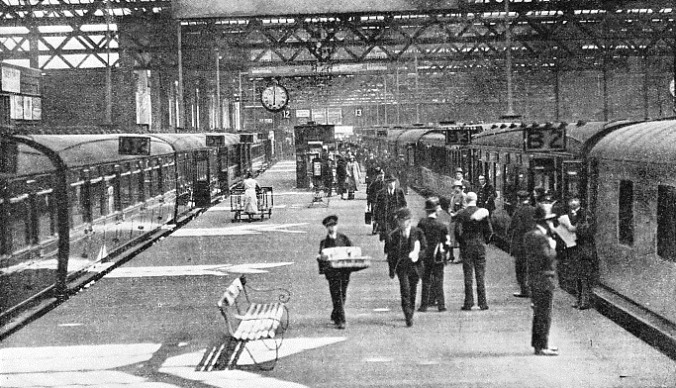
PLATFORMS 12 AND 13 at Euston Station, terminus of the Western Division of the LMS, are used by outward-bound expresses. In this part of the station are also two other express departure platforms 14 and 15, but the “Ulster Express” generally starts from Platform 13. The train runs daily, and from Mondays till Fridays leaves for Heysham, Lancashire, at 6.10 pm.
AT the beginning of the last century there were four main services between England and Northern Ireland. The 5.30 pm express from Euston to Liverpool and Manchester had a portion described in the time-tables of the period as the “Belfast Boat Express”, which left Crewe at 9 pm, and ran via Preston to the Lancashire port of Fleetwood, reached just before eleven. The connecting steamer arrived at Belfast about six the following morning. The Fleetwood-Belfast service dated from 1843. It was first operated by the North Lancashire Steam Navigation Company, which was afterwards acquired by the London and North Western and Lancashire and Yorkshire Railways.
Another Belfast service was provided be a direct steamer from Liverpool, connecting with an evening express from Euston. This service still exists.
The third service to Northern Ireland was via Holyhead and Greenore, Co. Louth. The “Greenore Boat Express”, leaving Euston at 6.30 pm., ran on the “Irish Mail” route as far as Holyhead. From Greenore through carriages were provided to Belfast and Londonderry.
The fourth service, via Stranraer (Wigtownshire) and Larne (Co. Antrim), operated the shortest sea-route between Great Britain and Ireland, but it involved a long railway journey into southern Scotland.
In 1904 the Midland Railway - now a part of the LMS - came into the arena with a Belfast express, which left St. Pancras, London, about 5 pm, and travelled by the Midland main line as far as Hellifield, Yorks, 234 miles from London. Leaving Hellifield, the train branched off from the main Carlisle line at Settle Junction, beyond the station of Long Preston. At Clapham, Yorks, it parted company with an alternative route to Carlisle via Ingleton, and at Wennington with its own line to Carnforth, in Lancashire. Crossing under the North Western main line at Lancaster, the express ran to Heysham, 267.7 miles from St. Pancras, where a steamer was waiting to take passengers to Belfast. Belfast was reached about 6.30 the next morning. Two of the four vessels employed on this route were turbine steamers; they were among the earliest turbine steamers employed on passenger services.
In the next few years there were some important developments. In 1906 the Great Western became a competitor for the Anglo-Irish traffic, when its Fishguard-Rosslare Harbour service was inaugurated. Day and night “Irish Mails” began to run on this route, and the monopoly of the London and North Western Irish Mail service was challenged. The Great Western attack, however, hardly affected the Belfast traffic, as its route via South Wales and Southern Ireland was too remote for competitive schedules to the north of the island.
By 1914 some further alterations had been made. The old 5.30 pm Liverpool and Manchester express had been superseded by three trains - an independent boat express for Fleetwood, with a through portion for Birkenhead, and separate expresses for Liverpool and Manchester. The two latter were the predecessors respectively of the “Merseyside Express” and of the “Lancastrian”. The “Greenore Boat Express” was now accelerated to leave Euston at 7.30, instead of at 6.30 pm, and made fewer stops.
The war of 1914-18 caused the disappearance of some Anglo-Irish services, which have never been reinstated. Among them was the “Greenore Boat Express”.
The next important step was taken some years after the Railways Act of 1921 came into force. After the fusion of the London and North Western and Midland Railways the Euston-Fleetwood and the St. Pancras-Heysham services became redundant, and a combination of the two seemed practicable. By 1928 we find a new express called the “Ulster Express” - running from Euston to Heysham, instead of to Fleetwood. There was no difficulty about the routing of this train, since the Midland line, as we have seen, crosses the London and North Western line at Lancaster. The St. Pancras-Heysham express lost caste, and was soon reduced to the status of a through portion on a Bradford express. The Euston-Heysham route represents a happy reconciliation of once conflicting interests. Western Division metals are used as far as Morecambe, beyond Lancaster, the remaining four and a half miles being on the Midland Division.
Four Outgoing Expresses
The “Ulster Express”, now working to an accelerated schedule, runs every day, including Sundays. From Mondays to Fridays, inclusive, it leaves Euston at 6.10 pm, and reaches Heysham at 10.52 pm, after stopping at Crewe, Preston. and Morecambe (Promenade). The distance to Heysham from Euston is 239 miles, or nearly twenty-nine miles less than that over the Midland route.
On Saturdays the “Ulster Express” leaves at 6.40 pm, and, stopping at the same stations though on an easier schedule, reaches Heysham at 11.33. On Sundays it leaves at 6.05 pm, and stops additionally at Rugby and Lancaster before reaching Heysham at 11.17 pm.
The connecting express from the Midland Division haves St. Pancras at 5 pm (4 pm on Saturdays in summer), and arrives at Heysham at 11.21. There is no service by this route on Sundays. Another connecting express, from Leeds and Manchester, on the Central Division of the LMS, reaches Heysham at 11.10 pm (11 pm on Saturdays). On Sundays this train starts from Manchester.
The steamer normally leaves Heysham about 11.40 pm and reaches Belfast about 6.30 the following morning. On Sundays it leaves ten minutes earlier.
Having dealt with the time-table aspect - a necessary preliminary if we are to understand what is required of the locomotives - let us take an imaginary journey on the “Ulster Express”. We will travel, say, on a Tuesday.
Euston Station is at its busiest every week-night between a quarter to six and a quarter past. Platforms 12, 13, 14, and 15 are all occupied by outgoing expresses. These are the 5.50 pm express to Birmingham and Wolverhampton; the “Lancastrian” for Manchester, leaving at 6 pm; the “Merseyside Express”, for Liverpool and Southport, leaving at 6.05 pm; and the “Ulster Express”, leaving at 6.10 pm. All these trains are fast. The 5.50 pm and the “Lancastrian” are the fastest, both having start-to-stop bookings exceeding 60 miles an hour - to Coventry (94 miles) and to Wilmslow, Cheshire (176.9 miles) respectively.
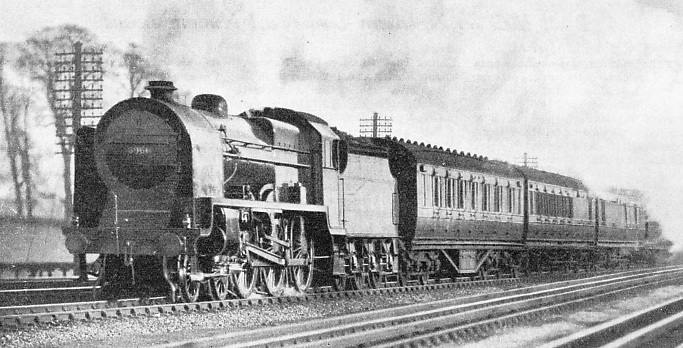
NEARING WATFORD, HERTS. 17½, miles from Euston. The “passing time” of the “Ulster Express” at Watford is twenty-three minutes. The 4-6-0 engine illustrated is one of the “Baby Scots”. In the foreground are the suburban electric lines which accompany the main line as far as Bushey (16 miles), where they diverge to serve Watford High Street Station, rejoining the main line at Watford Junction, where they end.
All four trains are made up of the latest corridor and vestibule stock, and lavishly equipped with dining accommodation. From the point of luxury there is very little to choose between them. The third-class compartments, with their comfortable seats, arm rests, and wide windows, are better than many firsts of a few years ago. As for the firsts, the saying that “first-class is first-class on the London and North Western” may be applied wholeheartedly to the LMS. The “Ulster Express” has an additional advantage - shared only with the “Merseyside Express” - in the form of a first-class lounge car, extending the whole width of the coach.
It would be unsafe to give a definite figure for the loading of the “Ulster Express”, as this naturally varies with the traffic. The total load, including a through carriage for Rochdale, detached at Crewe, may be about thirteen or fourteen coaches weighing, with passengers, staff, and luggage, about 430-465 tons. On Fridays there may be sixteen coaches, weighing about 550 tons laden.
The locomotive stock of the LMS is to-day fully adequate to its work The “Ulster Express” often has a “Royal Scot” at its head, though a “Baby Scot” or a Stanier “5XP” may be substituted. “Royal Scots” are, at the time of writing [1935], are the usual engines for three out of four of the expresses mentioned, though the recent multiplication of “Pacifics” may cause some changes in this respect. The “Merseyside Express” is normally in charge of a “Pacific” as it is a consistently heavy train.
The Evening Procession
Let us suppose that on the day of our journey we have a “Royal Scot” at the head of our train, and that it is made up to thirteen coaches and weighs 430 tons all found. A load of this size is well within the capacity of the engine. Since, however, the “Ulster Express” starts fourth in the evening procession to the north, it is liable to be affected by the vicissitudes of any one of the three trains in front as far as Rugby, where the Birmingham train diverges. Thence to Crewe it has two trains in front, and from Crewe to Weaver Junction, sixteen miles beyond Crewe, it follows the “Merseyside Express”. The necessity for strict time-keeping is therefore obvious. If, however, the engine-drivers are all enterprising, the “Ulster Express” may run well ahead of schedule. This happened one Friday in August, 1935, when, with a train of sixteen coaches, Rugby was passed six and Stafford seven minutes before time, Crewe being reached, in spite of a signal stop, five minutes early.
The schedule to Crewe, 158.1 miles in 167 minutes, demands an average speed from start to stop of 56.8 and a running average of fully sixty miles an hour, since there are three compulsory or “service slacks” - at Rugby (82.6 miles), near Polesworth (106.5 miles), and at Stafford (133.6 miles) , in addition to a difficult start.
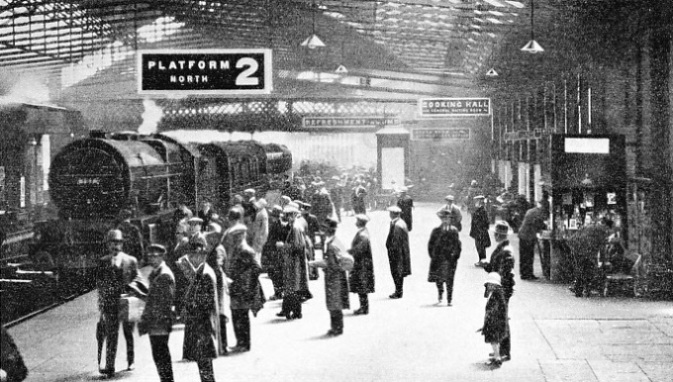
CREWE STATION is the first stop on the journey of the “Ulster Express”. The 158.1 miles from Euston to Crewe are scheduled to be covered in 167 minutes; this timing involves an average speed of 56.8 miles an hour and is the fastest on the journey. Engines are generally changed at this important junction, so the “Ulster Express” is allowed an eight minutes’ halt here.
All trains leaving Euston are faced with a formidable bank, about a mile long, varying in steepness from 1 in 70 to 1 in 112. From the top of this gradient however, for a distance of about one hundred and ninety miles, with a few exceptions, the Western Division main line is characterised by long undulating inclines, with a moderate ruling gradient of about 1 in 330. For the first thirty-one miles from the start to point just short of the Hertfordshire station of Tring the gradient is almost entirely adverse.
As far as Morecambe South junction, 232.9 miles from Euston, the train runs on the route of the Royal Scot, described in the chapter beginning on page 40. The present account, however, will deal more particularly with the gradients and certain aspects of the locomotive work,
Starting punctually at 6.10, our “Royal Scot” possibly No. 6110 “Grenadier Guardsman”, steams out of Euston and settles down to the climb of the bank outside the terminus. At the top of the bank, on the left, is seen Camden Shed, where many passenger locomotives of the latest types may be on view. These will include more “Royal Scots”, some “5XP’s”, “Baby Scots”, Midland compounds, and possibly a “Pacific”. On the right is Chalk Farm Station, on the suburban line to Broad Street.
There is a peculiar fascination about the left-hand side of the route. In addition to Camden Shed, both Wolverton Carriage and Wagon Works and Crewe Works are on this side, as well as most of the quarter-mile posts. The railway enthusiast - unless he is an expert in the art of rail-joint timing, explained in the chapter “Speed trains of Britain” - must therefore take care to secure a window-seat on the left-hand side, with the corridor on the right.
Another factor vitally affecting the enjoyment a journey by the “Ulster Express” is the season of the year. From May to July, thanks partly to the length of the days, which become longer in summer the farther north we travel, and partly to the Daylight Saving Act, virtually the whole of the run from Euston to Heysham is made in daylight. In winter it is dark the whole way. The traveller, unless he is uncannily acquainted with the route, cannot spot the quarter-mile posts in the dark. Let us assume, therefore, that our journey is taken on a fine evening in late June.
Having passed Camden, the “Ulster Express” plunges into Primrose Hill Tunnel emerging at South Hampstead. Immediately on leaving the tunnel it passes under the main line of the former Great Central Railway - now part of the LNER - from Marylebone. The line is now more or less level to Willesden Junction. At Queens Park, 3.7 miles from Euston, the Underground electric trains come up to the surface to run on the LMS suburban electric line to Watford. This line is seen on the right for the time being, but it changes sides after a few miles.
The Chiltern Hills
Willesden Junction is passed at about fifty-five miles an hour, the schedule time for the 5.4 miles being ten minutes - none too much when the Camden bank is taken into consideration. Even the fastest trains out of Euston are allowed nine minutes. At the seventh milepost, situated on a viaduct over the River Brent, there begins a climb of seven and a half miles at 1 in 339, through Wembley, Harrow and Wealdstone, and Hatch End.
Wembley Stadium - scene of so many sporting and athletic contests - is on the right of the station. Here the suburban electric line, having burrowed under the four tracks of the main LMS line, reappears on the left. A short distance beyond the station the Great Central main line to the north via Northolt Junction and High Wycombe crosses our route by an over bridge.
Precisely at the tenth mile-post the LMS line is crossed by the Great Central and Metropolitan line to Aylesbury and the north. Before and after this point Harrow School may be seen on its hill, to the left.
The long gradient may bring our speed down to fifty-five miles an hour. Although “Royal Scots” and most other modern LMS express locomotives have on occasion far exceeded sixty all the way up to Tring, our driver must withstand any temptation to “show the paces” of his engine. For, unless all the drivers in charge of the three trains in front are doing likewise, he will merely run into adverse signals if he strays too far ahead of schedule.
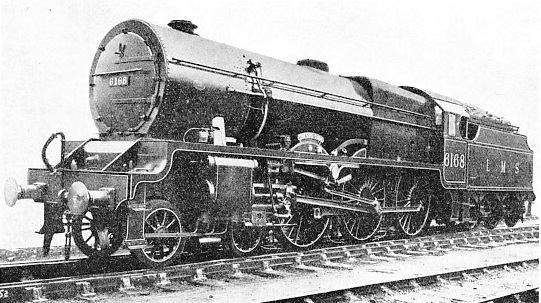
“ROYAL SCOT” CLASS LOCOMOTIVES are frequently used to haul the “Ulster Express”. Above is “The Girl Guide”, No. 6168 of the class. These 4-6-0 engines have 6 ft 9-in driving wheels, and three cylinders 18-in by 26-in. The total heating surface is 2,480 sq ft, boiler pressure is 250 lb per sq in, and grate area 31.2 sq ft.
The first water troughs are encountered on a level stretch at the top of the bank, just before Bushey Station, 16 miles from Euston. The London and North Western was the first railway to lay down water troughs - in 1860 - and our route is well supplied with them.
Taking advantage both of the drink and of the slight downward grade that follows, “Grenadier Guardsman” speeds through Watford Junction (17.5 miles) in twenty-three minutes from the start at about sixty-five miles an hour. The electric suburban line is now left behind for good - the local station is seen on the left - and we are faced with a unbroken climb of thirteen and a half miles to Tring Summit. Watford Tunnel over a mile long, is soon threaded. Watford Junction and the next three stations - Kings Langley, Hemel Hempsted, and Berkhamsted, are all exactly three and half miles apart, the quarter-mile posts being on or by the station platforms. If therefore, our traveller has not been able to obtain his window seat, or if he is travelling at the dark season of the year, he can still do some timing on this section.
The country gradually becomes more attractive as we approach the Chiltern Hills. The Grand Union Canal, one of the most important in England - accompanies the line for many miles.
Tring Summit, 31 miles from Euston, is passed at about fifty to fifty-five miles an hour, no higher speed being attempted because of the trains up front. The schedule time for passing Tring Station, 31.7 miles, is forty minutes, four minutes more than that of the “Lancastrian” in front.
There now follows a downhill stretch of fifteen miles to Bletchley, the first six miles of which are graded at 1 in 333. The first two miles are a deep cutting. The working time-table allows thirteen minutes, involving a pass-to-pass average of 69.1 miles an hour. If our driver could only give the engine its head, it could easily cover the fifteen miles in twelve minutes or less - the timing of the “Lancastrian”. As it is, he has to be content with keeping schedule and just touching, instead of averaging seventy-five miles an hour.
Bletchley, 46.7 miles, is due to be passed in fifty-three minutes. On the left of the junction is seen the branch to Oxford; on the right is concealed the branch to Cambridge. Members of either University may read some significance into this fact.
The grade is still favourable, and we soon come, near the 52nd mile-post, to the sidings of Wolverton Carriage and Wagon Works, on the left of the line. If we are lucky, we may see some of the latest LMS corridor stock resplendent in mint condition. Farther on, beyond Wolverton Station, 52.4 miles, are often seen, by way of contrast, some old carriages in various stages of disintegration.
Beyond Castlethorpe Troughs, 54 miles, there begins a tiresome ascent of nearly seven miles at 1 in 326-410-330 to Roade Summit, just before the 61st mile-post. Roade Station (59.9 miles; schedule sixty-five minutes) is passed at about fifty-five miles an hour. Now follows a short descent at 1 in 320 to Blisworth. Beyond Roade Station, in a deep cutting, the Northampton loop bears away to the right, not to rejoin our route before Rugby.
By-Passing the Black Country
As far as the divergence for Northampton, the main line has had four tracks, two for express and two for slow and goods traffic. Until Watford Junction was passed there were as many as six tracks, two of them for suburban electric trains. Henceforth we have to be content with a double track, which becomes triple or quadruple here and there, sometimes for long stretches.
We are due to pass Blisworth, 62.8 miles, in sixty-eight minutes. Blisworth is the junction for Northampton and for single-line branches to Banbury and to Stratford-on-Avon. At one time the Stratford branch belonged to an independent company, which changed its name from East and West Junction to Stratford-upon-Avon and Midland Junction Railway some years before its absorption by the LMS. This line has a separate though adjoining station at Blisworth, the existence of which has necessitated the placing of the 63rd mile-post on the right, instead of on the left of the line.
There now follows a virtually level stretch to Weedon, 69.7 miles from Euston. From Weedon Station a branch line, seen on the left, runs to Leamington Spa via Daventry, whose ancient fame acquired new laurels in recent years from its wireless broadcasting station. We are next faced with a climb at 1 in 490-350-415-640 to Kilsby Tunnel, 1 mile 666 yards long, at the top of a down grade, mainly at 1 in 370, to Rugby.
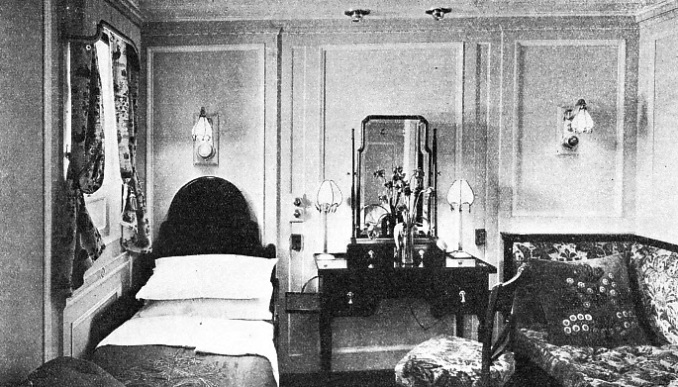
A LUXURY CABIN on board the SS Duke of Lancaster, a modern steamer owned by the LMS, and operating on the crossing between Heysham and Belfast. The Irish Channel crossing occupies nearly seven hours, the steamer leaving about 11.40pm and arriving at Belfast about 6.30am.
The “Ulster Express” may drop to about fifty-five miles an hour at the south entrance to Kilsby Tunnel, and its subsequent downhill speed will probably not exceed seventy miles an hour, because of the “service slack” to forty miles an hour through Rugby. As we descend from the tunnel we see on our right the Northampton loop-line approaching. Nearing Rugby the view is dominated by the Post Office wireless station at Hilmorton, with its lattice masts 840 ft high. Just before entering the station-yard at Rugby we become involved in a “flying junction” carrying the branch from Peterborough and, for the fourth time, pass under the main Great Central line of the LNER.
Rugby, 82.6 miles, is due to be passed in eighty-eight minutes. If all goes well, we shall probably be through the station a minute or two before time. From the station, in addition to the Northampton and Peterborough lines just mentioned, branch lines radiate south-west to Leamington and north to Leicester; but the most important line other than our own is the main line to Coventry and Birmingham, which runs at first almost due west from Rugby. This was originally the continuation of the main London and Birmingham Railway, the existing Trent Valley Line which we are to follow north-west being a later addition by-passing the Black Country. The Birmingham express is now off our track, leaving only the “Lancastrian” and the “Merseyside Express” in front.
Beyond Rugby the gradient continues to be favourable for about a mile to Newbold Troughs, which, of course, are on the level. The line then rises gradually to Shilton Summit, just short of the 92nd mile-post. A faint descent is followed by three miles down at 1 in 320 to Nuneaton, a manufacturing town mentioned in the disguise of “Milby” in a story by the novelist George Eliot. The line from Rugby has four tracks in places. The speed through Nuneaton is usually over seventy miles an hour.
Nuneaton, 97.1 miles from Euston, has to be passed in 103 minutes. The next fifteen miles are almost all downhill, the steepest gradient being two miles at 1 in 321 beyond Atherstone, an old market town on Watling Street. Watling Street, the Roman road from Dover through London to Chester, is still partly followed by the Holyhead Road of Telford. Until an unfortunate colliery subsidence near Polesworth (106.5 miles) some years ago the downhill stretch beyond Nuneaton was taken at high speed throughout, but the slack to about forty-five - or even to thirty - miles an hour now enforced over the subsidence makes this impossible.
At Tamworth (110 miles; schedule 116 minutes) our line passes under the important cross-country LMS line from Derby to Birmingham and Bristol. A few miles beyond the station the gradient ceases to be favourable. On a level stretch (113.5 miles) are Hademore Troughs. As these water troughs are situated in a dip, high speed may here be expected of trains travelling in either direction. The “Ulster Express”, having by now fully recovered from the Polesworth check, will probably touch seventy-two or more miles an hour in preparation for the shot climb ahead - mainly at 1 in 331 - through Litchfield.
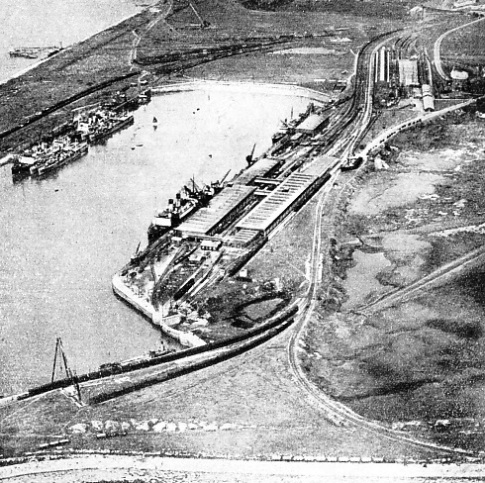 Lichfield, the birthplace of Dr. Johnson, is 116.3 miles from Euston and has to be passed in just over two hours - 122 minutes, to be exact. The red sandstone cathedral has three spires, known as the “Ladies of the Vale”, which are visible on the left of the line.
Lichfield, the birthplace of Dr. Johnson, is 116.3 miles from Euston and has to be passed in just over two hours - 122 minutes, to be exact. The red sandstone cathedral has three spires, known as the “Ladies of the Vale”, which are visible on the left of the line.
AT HEYSHAM. This photograph shows the LMS lines converging upon the dock. From Mondays to Fridays the “Ulster Express” covers the rail journey of 239 miles from Euston to Heysham in four hours forty-two minutes, arriving at the coastal terminus at 10.52pm. At week-ends the timings are modified, the train arriving at 11.33pm on Saturdays and 11.17pm on Sundays.
The top of the rise is gained before the 118th mile-post, and from here to Stafford the line is gently undulating. The little town of Rugeley (124.3 miles) is honoured with a “passing time” in the working time-table, the allowance being 130 minutes. From the next station, Colwich (127.2 miles), there diverges to the right a LMS branch to Stoke-on-Trent and Manchester. Although this line - formerly belonging to the North Staffordshire Railway - provides the shortest route between Euston and Manchester, the fastest expresses do not use it.
After Shugborough Tunnel the main line passes Milford and Brocton (129.5 miles) and at Trent Valley Junction (133.1 miles) it is joined by the original main line from Birmingham and Wolverhampton. The line curves a good deal about here, and speed is severely restricted. A passenger in a compartment towards the rear of the train will have no difficulty in seeing the engine from his window without having to lean out. The speed restriction, to forty miles an hour, continues through Stafford, 133.66 miles from Euston, due to be passed in 140 minutes. A LMS branch, running west to Wellington (Salop) and Shrewsbury, is used by a through service from Euston to Central Wales. A LNER branch runs east to Derby via Uttoxeter. Beyond Stafford the line, now quadruple as far as Crewe, is level for two and a half miles; but for twelve miles to the 148th mile-post there is an unbroken tough gradual ascent. This begins at 1 in 517, eases to 1 in 650, and steepens to 1 in 398 for the last three miles to the summit. If we are well up to time our driver will probably accelerate from the Stafford check to about fifty-five miles an hour and keep round about that figure all the way up. But if a special effort is called for he may exceed sixty. Whitmore Troughs are placed on the short piece of level ground at the summit. Whitmore Station (147.6 miles), just before the summit, is due to be passed in 156 minutes.
Before us now us a swift descent for the remaining ten miles to Crewe. Except for the formidable climb out of Euston, the steepest gradients on the southern section of the Western Division main line are here encountered. Fortunately for us they are downhill. Two miles at 1 in 348 are followed by over three miles at 1 in 177 to a point beyond Betley Road (153 miles). Thence three miles at 1 in 269 and a final short stretch at 1 in 330 bring us into Crewe.
The driver of the “Ulster Express”, having had an unchecked run so far - except for the three service slacks - may decide to give “Grenadier Guardsman” his head down this favourable incline. Over eighty miles an hour may be reached through Betley Road Station. On reaching Basford Sand Sidings (155.8 miles), however, this triumphal progress is checked; for we are approaching the maze of lines that make Crewe into one the most important railway junctions in Great Britain.
First Stop - Crewe
Crewe is 158.1 miles from Euston. The “Ulster Express” may improve on its schedule of 167 minutes by a minute or two. The passenger, observing lines coming in from all directions, may like to know that Crewe is the junction for important lines south-west to Shrewsbury, for Hereford, South Wales, and the West of England; west to Chester and Holyhead, for Ireland; south-east to Stoke-on-Trent and the Midlands; and north-east to Manchester. Neither of the two expresses remaining in front of us is booked to stop at Crewe, but they both have to pass through the station at ten miles an hour, which seems less than walking-pace after a spell at eighty. The “Lancastrian” is now off our route on its way to Manchester; the “Merseyside Express” stays ahead of us for a short while.
Engines are generally changed at Crewe. “Grenadier Guardsman” may give place to another 4-6-0, probably one of the “5XP” or “Baby Scot” class. If the train is very heavy, it may be piloted by a class 2, 4-4-0.
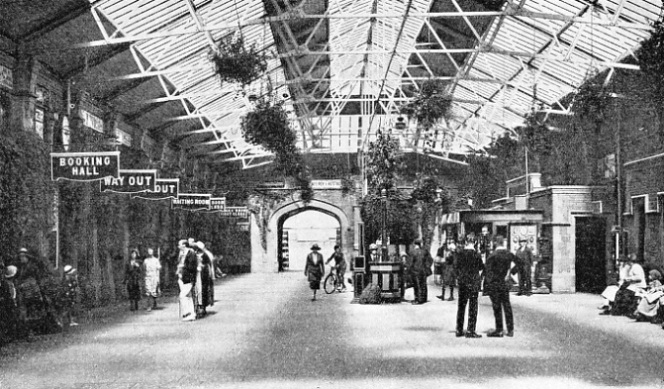
THE PROMENADE STATION at Morecambe, Lancs, is a terminus. An 0-6-0 tank engine is here attached to the rear of the train, and the big express locomotive is left at the station. The tank engine hauls the “Ulster Express” over the remaining four and a half miles of the 239-miles journey from London (Euston) to Heysham.
The time-table allows us eight minutes at Crewe, and we are soon off again on the next stage of the journey, to Preston, having detached the Rochdale coach. All goes well at first, as the initial four miles are dead level, and the gradients which follow are mainly favourable, until the 179th mile-post is breasted. The River Weaver us crossed beyond the salt-mining town of Winsford (7.4 miles from Crewe), and again beyond Acton Bridge (14.4 miles). At Weaver junction (16.2 miles; schedule eighteen minutes), at the foot of a short stretch at 1 in 330, the Liverpool line leaves us by means of a “flying junction”, eventually reaching Liverpool after crossing the Mersey via Runcorn Viaduct. At Weaver junction there is a speed restriction to about fifty miles an hour. A short rise at 1 in 330 is followed by a fairly sharp descent at 1 in 180, steepening after a mile to 1 in 112, and then easing to 1 in 567. Moore Troughs are passed just before Moore (21.2 miles). Here the “Ulster Express” will probably be running at over seventy miles an hour.
We next have to pass the Manchester Ship Canal, that artificial waterway which has converted the inland city of Manchester into one of the chief ports in Great Britain. To reach the bridges over the canal and the River Mersey, which also has to be crossed, the line rises sharply for one and a half miles at 1 in 135. On the other side it falls for the same distance and at the same inclination. But our driver cannot make full use of the down grade, as there is a slight speed restriction through Warrington.
Warrington, 24.1 miles from Crewe, has to be passed in twenty-six minutes. The train now enters upon what is scenically the least attractive part of its journey, as it has to traverse the manufacturing district of Lancashire. This it does not leave until after Preston, nearly twenty-seven miles farther on.
A slight rise to Winwick Junction, (27.5 miles) is followed by a sharp ascent of over two miles at 1 in 132-470-255-156 to Golborne Junction, 29.8 miles from Crewe and 187.9 miles from Euston. With the 188th mile-post the series of quarter-mile posts from London comes to an end, and a new series, starting from zero five-eighths of a mile before Golborne Junction, lasts as far as Preston, our next stop.
Through Industrial Lancashire
The stretch hence to Wigan does not invite high speed, as there may be restrictions due to colliery subsidences, Coal mines are seen on either side.
Wigan, 35.9 miles from Crewe and 194 miles from Euston, is passed, if there have been no delays, in thirty-nine minutes from the Crewe start. There now comes a steep ascent, four and a half miles long, to Coppull Summit, the steepest part being nearly two miles at 1 in 104, just beyond Wigan. At the top our speed may be under forty miles an hour. We pick up another pair of tracks at Standish Junction (39.1 miles), and the line is now quadruple as far as Preston. From Coppull (41.6 miles) to Preston we have over nine miles mainly down-hill. Although there are short strips as steep as 1 in 106 and 1 in 110, the general inclination is moderate. High speed is not usual because of a speed restriction to about fifty at Euxton Junction (45.5 miles schedule fifty minutes), where we are joined on the right by an important branch from Manchester. Nearing Preston there comes in on the left an equally vital branch from Liverpool. The River Ribble is crossed as we slow down for the stop.
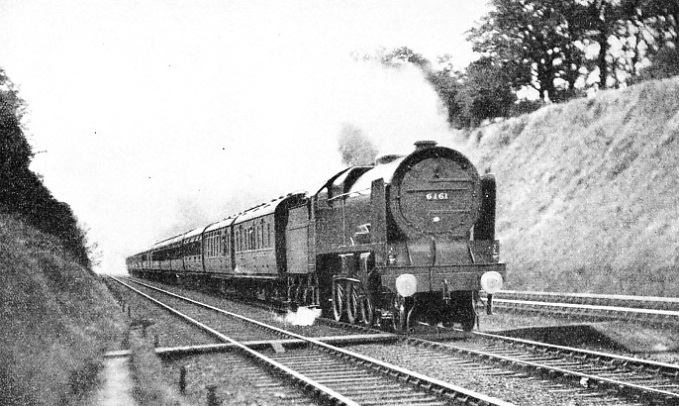
ON THE UP LINE, near Watford. The up “Ulster Express” though not as speedy as the down train, has a fast run from Rugby to Euston. Watford is at the foot of a long incline from a point near Tring, 13½ miles to the north-west. On this stretch speeds up to eighty miles an hour are common. The engine is No. 6161, “The King’s Own”, one of the “Royal Scot” class.
Preston is 50.9 miles from Crewe and 209 miles from Euston. It is due to be reached in fifty-eight minutes from Crewe, and in seven minutes short of four hours from Euston. The fastest service, however, between Preston and Euston is provided by the up “Blackpool and Fylde Coast Express”, which covers the distance, including a stop at Crewe, in 3 hours 37 minutes. Many important trains stop at Preston. Even those that do not stop have to slow down to about ten miles an hour because of the sharp curve beyond the station. On the west side of the station are the platforms of the former Lancashire and Yorkshire Railway - now the Central Division of the LMS. These platforms deal with the heavy Blackpool and Fylde Coast traffic. In the days of the Fleetwood boat express, to which reference has already been made, passengers for Northern Ireland were here switched off the main Euston-Carlisle line, and taken to Fleetwood on Lancashire and Yorkshire metals.
The “Ulster Express”, however, keeps to the main line for over twenty miles more, Train-timers should note that the second series of quarter-mile posts (from Golborne Junction) has come to an end and that a third series, likewise starting from zero, begins at Preston. This series ends at Carlisle.
The twenty-one miles from Preston to Lancaster are virtually level, except for about a mile at either end. Leaving Preston after a halt of five minutes, the “Ulster Express” climbs at 1 in 101-173 to reach this almost level tract. Near the eighth mile-post (217 miles from Euston) the engine takes its final drink - from Brock Troughs.
The industrial belt is now left behind, and the scenery gradually becomes more and more attractive. Dim mountain shapes may be descried on the horizon in the light of the setting sun. The rocky nature of the soil is expressed in the stone walls which take the place of hedges. From Lancaster Old Junction. (19.9 miles) the line suddenly drops from the low table land at a gradient of 1 in 98. Lancaster (21 miles from Preston and 230 miles from Euston) is due to be passed in twenty-two minutes from the Preston start.
The sea is now very near. We cross the River Lune, near its mouth, just beyond Lancaster, and slow down for Morecambe South Junction (22.9 miles), where we leave the main LMS line to Carlisle and Scotland. We have now reached the shores of Morecambe Bay, on the farther side of which if it is still light, may be seen the outlines of the Lake Mountains guarding their fairyland of beauty. The “Ulster Express” halts at Morecambe (Promenade) Station, on the Midland Division of the LMS, having covered the twenty-five miles from Preston in thirty minutes.
The Promenade Station at Morecambe is a terminus. A sturdy 0-6-0 tank engine is attached to the rear of the train, and the express locomotive is left behind in the station. After a halt of four minutes the tank engine manfully hauls the train over the remaining four and a half miles to Heysham. Heysham, 239 miles from Euston, is reached at 10.52 pm, in 4 hours 42 minutes from the start. The railway part of the journey is now over.
A word or two about the steamers may not be out of place. When the new service was inaugurated on April 30, 1928, three new twin-screw turbine steamers, each of 3600 tons, and having a speed of 21 knots, were placed in service. They were Duke of Argyll, Duke of Lancaster, and Duke of Rothesey. At the time of their introduction they were the largest, fastest, and most luxurious vessels employed on cross-Channel services. A feature of the design is the lavish provision of single-berth cabins. Together with Duke of Abercorn, of 2,217 tons and steaming 21½ knots, they sufficed for the Heysham-Belfast service. In March, 1935, however, the fleet was strengthened by the launching of Duke of York, a vessel capable of 21 knots.
At normal times one of these steamers is waiting for the train at the quay side, but on Friday nights in the summer no fewer than three are required to deal with the traffic. The last of the boat expresses arrives, and the steamer leaves at about 11.40 pm. About 6.30 am the following morning it is due at Donegall Quay, Belfast.
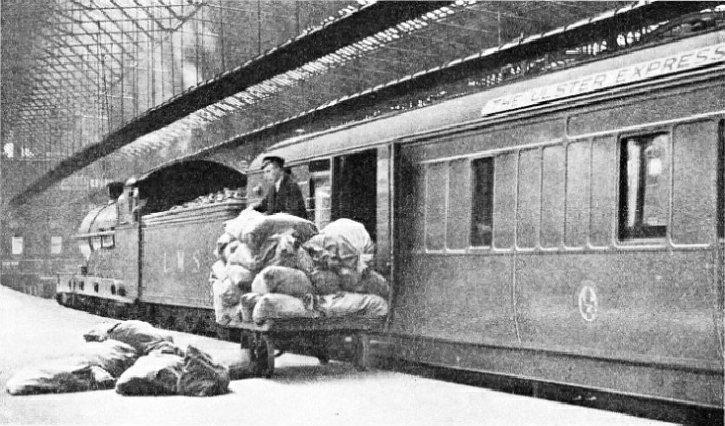
THE UP “ULSTER EXPRESS” at the end of the journey at Euston Station. The train arrives at London at 11.0am, with the mail from Northern Ireland. The train in this illustration has been hauled by a 4-6-0 locomotive of the “Claughton” class, which was generally withdrawn from service in 1935.
You can read more on “Ireland’s Railway Systems”, “The Irish Mail”, “The Royal Scot Route” and “The Story of the LMS” on this website.








 Lichfield, the birthplace of Dr. Johnson, is 116.3 miles from Euston and has to be passed in just over two hours -
Lichfield, the birthplace of Dr. Johnson, is 116.3 miles from Euston and has to be passed in just over two hours -

